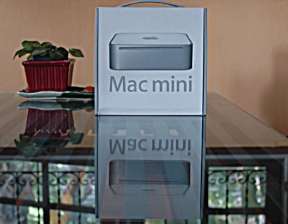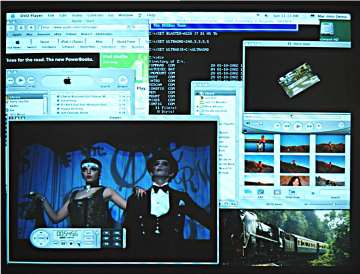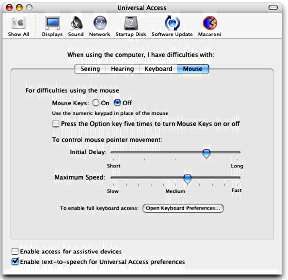
eXtensions
|
Mac mini (2): The Flexible Mac mini |

A few days with the new Mac mini left me wanting more. Not that there is anything technically new with this machine: its size and its price are currently making it one of the most desirable computers and there are back orders worldwide.
I had the 1.25GHz version to play with, like the eMac I have been using problem-free for the last 6 months (it has been on all that time apart from restarts after updates). It apppeared slightly slower than the eMac, perhaps due to the different speeds of hard disks used. There was also new software to play with.
 I did the usual tricks of having several applications running at the same time. One of these being the DVD Player meant that the screenshot facility is crippled, so I had to take a real photograph with a less than stellar monitor. As well as scenes from Cabaret, I had open iTunes, iPhoto, Preview (for pdf files), a QuickTime movie, the Safari browser, and a DOS Window. I used an emulator called DosBox. There are also Bochs, and Virtual PC (now owned by Microsoft) if you really need to run Windows applications.
I did the usual tricks of having several applications running at the same time. One of these being the DVD Player meant that the screenshot facility is crippled, so I had to take a real photograph with a less than stellar monitor. As well as scenes from Cabaret, I had open iTunes, iPhoto, Preview (for pdf files), a QuickTime movie, the Safari browser, and a DOS Window. I used an emulator called DosBox. There are also Bochs, and Virtual PC (now owned by Microsoft) if you really need to run Windows applications.
Apart from using it at home on a small network, I took it in to work in my backpack. Several days of such treatment caused no problems, although with a large camera and all my papers, the weight was noticeable. The same would apply with a laptop computer (Mac mini, 1.32 kg; 12" PowerBook, 2.1 kg). The mini also has a power supply, looking like a white brick (made in Thailand: Delta Electronics).
With the daily location change, I created two sets of networking data. Switching between the two was just a mouse click and would not require a restart. At home, not only was Internet access total simplicity, I used the Sharing facility in iTunes to play music from the eMac upstairs, using the Mac mini downstairs. As a twist, I then managed to have the eMac play music from the mini: both running at the same time. On both computers, a message told me port 49152 had to be opened. OSX comes with all firewall ports closed by default.
The size, weight and price (as well as OSX) mean that a lot of people are beginning to experiment with Mac minis. Apple were aiming at three markets (PC switchers, Mac owners expanding their systems and iPod owners), but there are several more developing.
Despite the non-user-accessible environment, many people are reporting making some advanced adaptations: two ethernet cards, soldering on audio connectors, changing hard disks (even MacInTouch reports this as not recommended because of the space problems), putting them in cars, adding a back-light to the top, installing OSX server. Apart from the last (which I think is a brave and good idea), I am a coward on this sort of thing, apart from the warranty-voiding risk. I do not mind putting a new disk into a G4 or G5: not the eMac, and certainly not the mini, especially when some local retailers are so helpful.
I am told that Mac minis here will have the standard configurations. Additions like Airport or Bluetooth will have to be done by the importer (not the retailers), but no prices are known as the parts are not available yet.
 The main criticism that diehard critics (better to say something negative and appear sophisticated) have concerns the "headless" nature of the beast: no monitor, no keyboard, no mouse. I circumvented this quickly by borrowing a monitor from work (I had to assess it for my employers, no?), using a spare keyboard I had, and sharing the mouse. If I had a second computer permanently, I would pick up a Logitech mouse from one of the IT shops in town.
The main criticism that diehard critics (better to say something negative and appear sophisticated) have concerns the "headless" nature of the beast: no monitor, no keyboard, no mouse. I circumvented this quickly by borrowing a monitor from work (I had to assess it for my employers, no?), using a spare keyboard I had, and sharing the mouse. If I had a second computer permanently, I would pick up a Logitech mouse from one of the IT shops in town.
Mind you, with OSX you can have mouse use without a mouse. In Network Preferences > Universal Access, there are the settings for those less fortunate: those with seeing difficulties, hearing problems or with physical handicaps. The inerface can become easier to use for these; and this includes a setting by which the cursor can be controlled by the number-pad. It is painfully slow but if someone cannot handle a mouse, this is a built-in alternative.
Mac users moving to a new computer can use the utility called Setup Assistant that comes with the latest machines. PC users could try Move2Mac to transfer files. I would also strongly recommend a program like Lapcop that reports back if the computer is used elsewhere: the small size means it could easily disappear.
Rebeca Freed, wrote in PC World, "If I were recommending a starter system to someone (who hadn't already taken a side in the Mac versus Windows holy war), I wouldn't hesitate to send them in the direction of the Mac Mini."
The Mac mini is a lower priced (not cheap) way into the Mac world and OSX. Some people will never have Macs -- never want to -- sticking with Windows whatever.
Note: See also

For further information, e-mail to Graham K. Rogers.
Back to
eXtensions
To
eXtensions: Book Reviews
To
eXtensions: Year One
To
eXtensions: Year Two
Back to homepage